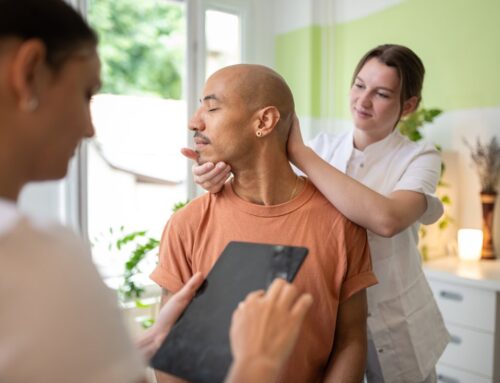Back to School Health Tips: How Burlington Students Can Avoid Neck and Back Pain
As the school season kicks off in Burlington, it’s important for our students to get back into a healthy routine—not just for their academic performance but for their physical well-being as well. One common issue many students face is neck and back pain, often due to the combination of heavy backpacks, prolonged sitting and forward neck posture. Here’s how Burlington students can steer clear of these discomforts and stay pain-free throughout the school year.
Pack it Light and Wear it Right
The Ontario Chiropractic Association had a campaign called “Pack it light and wear it right.” It’s self-explanatory. If you load up your backpack too much, it has a chance of irritating the spine, which isn’t ideal for a young person who is growing. “Wear it right” means using all the straps and having the pack sit appropriately against the length of your spine, not sagging too low. I often see students in Burlington with the straps completely loose and the pack resting at the base of the spine. The following are a few pointers for using a backpack.
- Size and Fit: Make sure the backpack is proportional to the student’s body size. It shouldn’t be too large or too small.
- Padded Straps: Choose a backpack with padded, adjustable shoulder straps. This will help distribute the weight more evenly.
- Waist and Chest Straps: Look for backpacks with waist and chest straps. These help to distribute the weight more evenly and reduce strain on the shoulders and back. Although the kids in Burlington might not think it looks cool to have all the straps done up, back pain isn’t cool, either!
- Weight Limit: Ideally, the backpack should not exceed 10-15% of the student’s body weight. Encourage students to carry only what’s necessary.
- Organize Items: Place heavier items closest to the back and lighter items towards the front. This helps keep the weight distributed more evenly.
- Use Both Straps: Always use both shoulder straps to evenly distribute the weight. Sure, it looks cool to sling it over one shoulder, but it’s a good way to create an asymmetrical loading around the spine and irritate muscles and joints.
Promote Good Posture
In the past, there was a large emphasis on sitting with “perfect posture,” and we would hand out ergonomic sheets to patients so that they could avoid pain and long-term spinal problems. I’m not sure I agree with this fear mongering about posture. Ideally, the spine likes to move. Get up and move around. Occasionally, you can slouch. Your spine is robust and not as fragile as some people might believe. At the same time, if you had to flip a coin, I would prefer someone to try and sit “properly” with the neck not leaning forward for prolonged periods. Here are some common ideas and recommendations for being at your desk all day.
- Desk Setup: Ensure that the student’s desk and chair are ergonomically set up. The desk should be at elbow height, and the chair should support the lower back.
- Screen Position: If using a computer, the screen should be at eye level to avoid straining the neck. The student should avoid leaning forward or slouching.
- Regular Breaks: Encourage students to take breaks every 30-60 minutes to stand up, stretch, and walk around. This helps reduce muscle stiffness and improve circulation.

Incorporate Stretching and Exercise
Regular physical activity and stretching can strengthen the muscles supporting the spine and improve flexibility. Here’s how students can incorporate these into their routines:
- Stretching Exercises: Simple stretches for the back, neck, and shoulders can help alleviate tension. Incorporate stretches such as neck tilts, shoulder rolls, and seated forward bends. A little bit of discomfort isn’t necessarily a bad thing. If a stretch feels a little uncomfortable it might be a suitable one for you to try and improve upon. Consult with your chiropractor, physiotherapist or massage therapist to see what stretches are appropriate for you.
- Strength Training: Engaging in activities that strengthen the core muscles can provide better support for the spine and reduce the risk of pain. Strengthening is always a good idea, but the program you choose might need to be scaled and designed with your ability and individual needs in mind. Strengthening is probably the best way to prepare your body for the physical demands of life. Again, consult with your chiropractor, physiotherapist or massage therapist to see what strengthening exercises are appropriate for you.
Mind the Tech
With the rise in screen time, students should be aware of how their tech usage can impact their posture:
- Phone Use: When using a smartphone, encourage students to hold the phone at eye level instead of bending their neck to look down.
- Laptop Ergonomics: If using a laptop, a stand or external keyboard can help maintain a better posture.
Listen to Your Body
Lastly, students should learn to listen to their bodies. If they start experiencing discomfort or pain, it’s important to address it early on rather than ignoring it. Encouraging regular check-ins on physical well-being and seeking medical advice, when necessary, can prevent more serious issues.
By following these tips, Burlington students can enjoy a healthier and more comfortable school year. Remember, maintaining good posture, packing smart, and staying active are key strategies for avoiding neck and back pain. Here’s to a successful and pain-free school year!
Feel free to share these tips with fellow students and parents to help spread the word about staying healthy this school season.








